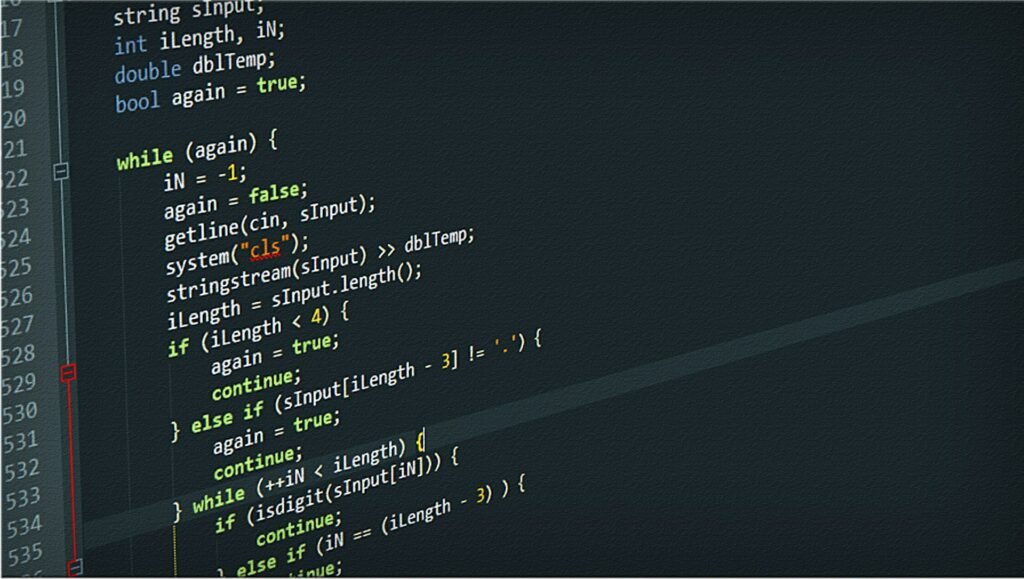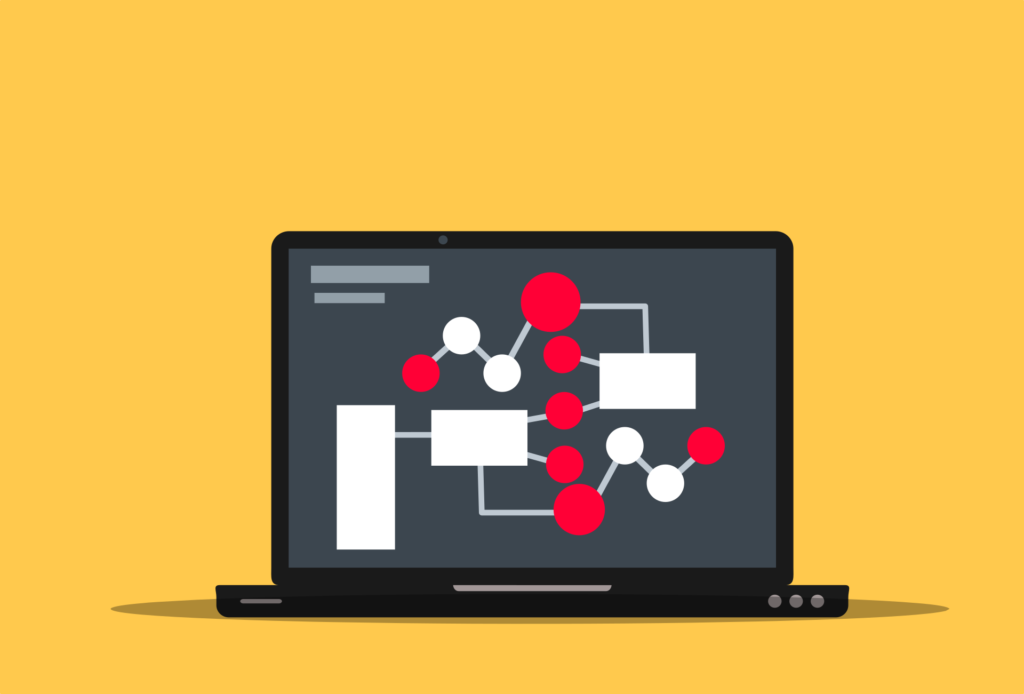Scala
A general-purpose programming language referred to as Scala blends the ideas of functional and object-oriented programming. It was first made available in 2003 and was designed by Martin Odersky. Scala is useful for a wide range of applications since it is designed to be brief, expressive, and scalable.

Here are a few of Scala’s notable characteristics.
- Object-Oriented Programming (OOP) – Scala is entirely OOP, which means that each value is an object and each operation is a method call. Like other OOP languages, it supports classes, objects, inheritance, and polymorphism features.
- Functional Programming (FP) – Scala also adopts the principles of functional programming (FP). It regards functions as first-class citizens and enables the usage of higher-order functions as well as the passing of functions as arguments and returns from functions. Additionally, it promotes the usage of immutability and pure functions and enables immutable data structures.
- Static Typing – Because Scala is statically typed, types are verified at build time. Its robust type inference engine may frequently automatically infer types, avoiding the requirement for explicit type annotations.
- Interoperability – Scala is made to work in combination with Java code already in existence. There are no problems calling Java code from Scala and vice versa. Because of this, integrating Java libraries and frameworks into Scala projects is simple.
- Scalability – Scala is renowned for its ability to scale. Through features like actors and the Akka framework, it offers built-in support for concurrent and parallel programming. Through libraries like Apache Spark, distributed computing is also supported.
- Expressivity – Scala provides a clear and expressive syntax that enables programmers to produce code that is both expressive and readable. Several sophisticated language features, like pattern matching, higher-order functions, and implicit conversions, are provided by it. These features allow for strong abstractions and cut down on boilerplate code.
The fields of web development, data analysis, distributed systems, and big data processing have all seen an increase in popularity for Scala. Many businesses, like Twitter, linkedin, Netflix, and Airbnb, use it.
Advantage and disadvantage of scala
Advantages of Scala.
- Scalability – Scala’s architecture makes it scalable, enabling programmers to create applications that can deal with rising user bases and higher workloads. It is highly suited for managing concurrent workloads and using multi-core processors since it has built-in support for concurrent and parallel programming.
- Expressive and Concise syntax – Developers may write code that is simpler for users to understand and maintain because of Scala’s expressive and concise syntax. It offers functional programming techniques like pattern matching and higher-order functions, enabling beautiful and efficient solutions to challenging issues.
- Interoperability with Java – Scala’s complete interoperability with Java enables the simple integration of Java code into Scala projects and vice versa. Because of this compatibility, it is simple to use the many Java libraries and frameworks that already exist.
- Strong Static Type System and Type Inference – Scala features a strong static type system that detects many problems at compile time, resulting in more durable and dependable code. Furthermore, the type inference system in Scala frequently may infer types automatically, avoiding the need for explicit type annotations and streamlining the code.
Disadvantages of Scala.
- Higher Learning Curve – When compared to several other programming languages, Scala may have a higher learning curve. Developers may need to learn new ideas and coding methods because it mixes the object-oriented and functional programming paradigms. For beginners, the language’s extensive features and expressive syntax may be too much.
- Compilation Time – Scala’s complex features and strong type system can occasionally result in lengthier compilation times, particularly for bigger applications. Scala’s compilation process can be slower than those of languages like Java, which may have an effect on development productivity, especially when fast iterations are required.
- Limited Tooling and Libraries – Although the ecosystem of Scala’s libraries and tools is expanding, it may still be thought of as being smaller than languages like Java or Python. This might limit the productivity advantages associated with using Scala by forcing developers to create more custom code or rely on Java libraries in some circumstances.
- Community and Support – Although the Scala community is vibrant and helpful, it may not be as big or well-established as some other programming language communities. It could be more difficult to locate specialized help or resources for particular use cases or libraries.
Best characteristics of scala
Scala is a recognized and effective programming language because of a number of unique qualities.
- Object-Oriented and Functional Paradigms – Scala combines the object-oriented (OOP) and functional (FP) paradigms in a seamless manner. It allows for sophisticated functional programming approaches by treating functions like first-class citizens. In addition, it offers complete support for OOP ideas like classes, objects, and inheritance. Developers benefit greatly from the flexibility and creative power this combination offers.
- Expressive and Concise Syntax – Scala’s syntax is intended to be expressive and condensed, making it easier for programmers to generate legible and manageable code. It provides a wide range of expressive features and linguistic structures, including pattern matching, higher-order functions, and implicit conversions. These tools let programmers create beautiful, condensed code.
- Type inference – The advanced type inference mechanism in Scala eliminates the need for explicit type annotations by automatically determining types. Code becomes less verbose while still having strong static typing as a result, making it easier to read and increasing developer productivity.
- Scalability and Concurrency Support – Scalability and concurrent programming support are two of Scala’s best-known features. It offers integrated concurrency primitives like actors and the Akka framework, enabling programmers to create scalable and highly concurrent systems. Because of this, it is ideal for creating programs that effectively utilize multi-core computers and can manage heavy workloads.
- Smooth interoperability with Java – Scala’s compatibility with Java enables programmers to use their current Java codebases, libraries, and frameworks. It is simple to incorporate Scala into already-existing Java projects or make use of Java tools and libraries since Scala code may call Java code and vice versa without any problems.
- Rich and Powerful Collections Library – The Scala collection library is rich and powerful, offering a broad range of collection types and high-level collection functions. It provides functional-style operations like map, filter, and reduce as well as changeable and immutable collections. Developers may deal with data structures in an effective and expressive manner thanks to the collection’s library.
- Vibrant and Active Community – Scala has a thriving and active developer community that contributes to its environment. In order to improve the development process and solve different use cases, the community offers an extensive range of libraries, frameworks, and tools. Additionally, this vibrant community offers forums, tools, and assistance to developers so they can communicate, exchange information, and work together.
Scala tutorial
Here are some suggested Scala lessons and study guides.
- Scala Documentation – Including tutorials, language features, and code examples, the official Scala documentation offers a thorough introduction to the language. It is accessible via https://docs.scala-lang.org, the official Scala website.
- Scala School – Scala School is an appreciated online lesson that teaches the fundamentals of Scala in a fun and interactive way. Through practical exercises, the syntax, features, and ideas of Scala are introduced. This link will take you there.
https://twitter.github.io/scala_school/
- Scala Exercises – An interactive learning platform that provides a range of Scala exercises and challenges is called Scala Exercises. It covers a range of subjects, from elementary grammar to sophisticated ideas. While studying, you may test your knowledge and practice coding activities. Visit https://www.scala-exercises.org to access it.
- “Programming in Scala” book – The book “Programming in Scala” offers a thorough introduction to Scala programming. It was written by Martin Odersky, Lex Spoon, and Bill Venners. It discusses programming methodologies, language features, and industry standards. It is frequently cited as a reference work for Scala programmers.
Scala compiler online
You can try the following online Scala compilers if you’re searching for a quick way to test and run Scala code without having to set up a local development environment.
- Scastie – An interactive Scala compiler and editor are available through this online Scala playground. You can use your browser to write, compile, and run Scala code. Scastie may be accessed at https://scastie.scala-lang.org/.
- Tutorialspoint – You can develop and run Scala code right in your browser with tutorialspoint’s online Scala compiler. It offers a straightforward interface where you can enter code and view the results. Visit https://www.tutorialspoint.com/execute_scala_online.php to access the tutorialspoint Scala compiler.
- Jdoodle – jdoodle is an online coding environment that supports Scala as well as many other programming languages. You may develop and run Scala code using the available online Scala compiler. The jdoodle Scala compiler may be accessed at https://www.jdoodle.com/execute-scala-online.
- Onlinegdb – An online integrated development environment and compiler, onlinegdb supports a number of programming languages, including Scala. It offers a user-friendly interface where Scala code may be written and executed. Visit https://www.onlinegdb.com/online_scala_compiler to access the onlinegdb Scala compiler.
Scala programming languages
Instead of being a group of programming languages, Scala is a programming language in and of itself. It is a general-purpose, statically typed computer language that blends the functional and object-oriented programming paradigms.
Scala is an acronym for “Scalable Language” since it was created to be scalable and suited for a variety of applications. It was first made available in 2003 and was designed by Martin Odersky. The Java Virtual Machine (JVM), on which Scala is running, enables smooth communication with Java programs.
With Scala, you can create clear and expressive code, make use of rich JVM ecosystem, and powerful functional programming approaches. By default, it offers characteristics like type inference, pattern matching, higher-order functions, and immutability.
Web development, data analysis, distributed systems, and large data processing are just a few of the fields where Scala is applied. It is used by businesses including Twitter, linkedin, Netflix, and Airbnb and has a growing community.
Scala language
The object-oriented and functional programming paradigms are combined in Scala, a strong and expressive programming language. Its compactness and scalability enable developers to create attractive, maintainable code. Scala is appropriate for a variety of applications since it runs on the Java Virtual Machine (JVM) and seamlessly integrates with Java. Higher-order functions, pattern matching, type inference, and immutable data structures are just a few of the features it offers. Scala is utilized in many different fields, such as web development, data analysis, and distributed systems. It has a vibrant community and expanding ecosystem.
What is scala
A general-purpose programming language called Scala blends the functional and object-oriented programming paradigms. It was originally made available in 2003 and was designed by Martin Odersky. Because Scala is intended to be scalable and adaptable to a variety of programming jobs, the name “Scala” is an acronym for “Scalable Language”.
The Java Virtual Machine (JVM), on which Scala runs, enables smooth communication with Java programs. It inherits the robust Java ecosystem, which includes libraries and tools, making it simple to use the Java resources already in place.
Scala provides developers with a clear and expressive syntax that makes code more understandable and manageable. It comes standard with support for characteristics like type inference, pattern matching, higher-order functions, and immutability. These characteristics make functional programming approaches easier to use and provide for clear, expressive solutions to challenging issues.
Scala vs java
Popular programming languages Java and Scala both utilize the Java Virtual Machine (JVM). Even if they have certain things in common, they also differ greatly.
These provide a Scala vs. Java comparison.
- Syntax and Expressivity – When compared to Java, Scala offers a more brief and expressive syntax. It provides strong language constructs that enable more expressive and condensed code, including as type inference, pattern matching, and higher-order functions. Java, on the other hand, lacks some of these expressive capabilities and has a verbose syntax.
- Object-Oriented and Functional Programming – Scala and Java are both object-oriented programming languages, but Scala offers more powerful functional programming capabilities. Scala includes characteristics like immutability by default and strong collection operations and respects functions as first-class citizens. With the advent of lambda expressions and the Stream API in subsequent versions (Java 8 and beyond), Java introduced functional programming principles, although Scala’s functional programming capabilities are more comprehensive.
- Interoperability – Scala is completely compatible with Java in terms of interoperability. Java and Scala calls may be made without any problems. This implies that Java libraries, frameworks, and tools may be used in Scala applications and vice versa. The coexistence and collaboration of Java and Scala projects are possible.
- Type System – When compared to Java, Scala features a more complex and expressive type system. You can create code with fewer explicit type annotations thanks to its support for sophisticated type inference. By doing this, boilerplate code is reduced, and the code becomes shorter and easier to understand. In contrast, Java often necessitates explicit type annotations.
- Parallelism and concurrency – Scala comes with built-in concurrency support through the use of actors and the Akka framework. It offers apis and concepts to make building concurrent and parallel code simple. The java.util.concurrent package and the Fork/Join architecture in Java both enable concurrency, although Scala’s concurrency capabilities are frequently regarded as being more robust and expressive.
- Community and Ecosystem – Java has a huge community as well as a mature ecosystem that includes several libraries, frameworks, and tools. For many years, it has been widely used, and there are many resources and supports accessible. Even though it is expanding, Scala’s ecosystem and community are still smaller than Java’s. However, it has a vibrant and engaged community with a number of libraries and frameworks targeted toward particular industries.
Scala programs
The Scala programming language, which is robust and expressive and runs on the Java Virtual Machine (JVM), is used to create Scala programs.
These serve as an illustration of a basic Scala program.
object mitacademys {
def main(args: array[string]): unit = {
println(“welcome to mitacademys!”)
}
}
In this illustration, we define an object called mitacademys that acts as the program’s entry point. We define a main method, which serves as the execution’s starting point, within the mitacademys object. As an argument, it accepts an array of strings called args.
We output the phrase “welcome to mitacademys!” to the console using the println function within the main method.
Normally, you would create this Scala program using the Scala compiler (scalac), then run it using the Scala runtime (scala). But you can also run Scala code online using online Scala compilers, so you don’t even need a local development environment.
Scala download
These steps can be used to download Scala.
- Check out the Scala language’s official website at https://www.scala-lang.org.
- The “Download” tab may be found on the top navigation menu.
- You may get Scala through a variety of methods on the download page. Depending on your operating system and needs, select the right package. The choices on offer could include.
- Scala for the JVM – This version of Scala is the one that is often installed on the Java Virtual Machine. For the majority of developers, it is their preferred option.
- Scala Native – Bypassing the JVM, this option enables you to compile Scala code to native executables. High-performance, standalone applications are its main use case.
- Scala.js – With this option, you can compile Scala code to javascript and use it to create web apps.
- You will be sent to a download page after choosing the desired bundle. To begin the download procedure, click the download link.
- You can go on to the installation step unique to your operating system when the download is finished.
It’s important to note that because Scala uses the Java Virtual Machine, your machine must have the Java Development Kit (JDK) installed. Before installing Scala, make sure you have a suitable JDK installed.
If you’d rather use a package manager, you may also see if Scala is offered by your chosen one (for example, Homebrew for macos or apt-get for Ubuntu). This makes it simple to update Scala and allows you to install it with only a few short keystrokes.
Scala ide
An Integrated Development Environment (IDE) known as a Scala IDE is one created especially for creating applications with the Scala programming language. For Scala developers, the Scala IDE offers a collection of tools and features that increase productivity and streamline the development process.
Here are a handful of the renowned Scala ides that are readily available.
- Intellij IDEA – A popular IDE that supports several programming languages, including Scala, is intellij IDEA. With functions like code completion, syntax highlighting, refactoring, debugging, and interaction with build tools like sbt and Maven, it offers thorough support for Scala programming.
- Eclipse with Scala IDE – Scala IDE for Eclipse is an Eclipse-based IDE that has been specially designed for Scala programming. It has features like syntax highlighting, intelligent code completion, debugging help, and interaction with appreciated build tools like sbt and Maven.
- Scala plugins for Visual Studio Code (VS Code) – Scala development may be supported by adding plugins to VS Code, a portable and flexible code editor. VS Code supports a number of Scala plugins, including Scala (Metals), Scala Syntax (official plugin), and Scala Syntax (ammonite).
For effective Scala programming, these ides offer a variety of capabilities and integrations with build tools, version control systems, and other developer tools. The IDE you choose will rely on your preferences, the needs of your project, and the development ecosystem you are using. It is advised to check out various ides to see which one best fits your requirements and workflow.
Scala vs python
Although both Python and Scala are widely recognized programming languages, they have different design philosophies and use cases.
Here are some significant distinctions between Python and Scala.
- Purpose and Domain – Scala is a general-purpose, statically typed programming language that runs on the Java Virtual Machine (JVM). It is frequently used to create scalable, high-performance applications, especially in the fields of distributed systems and massive data processing. It mixes object-oriented and functional programming paradigms. On the other hand, Python is a high-level, dynamically typed programming language renowned for its clarity and readability. Web development, data analysis, scientific computing, machine learning, and scripting are just a few of the areas where it is frequently utilized.
- Syntax and Style – Scala’s syntax is more complex than Python’s. It is a powerful and expressive language that takes inspiration from both Java and functional programming languages like Haskell. The syntax of Scala can be more verbose and frequently requires explicit typing. Python, on the other hand, places a strong emphasis on readability and simplicity with clear and short syntax. Its code is frequently shorter and simpler to develop and comprehend.
- Type System – Because of Scala’s static type system, variables and expressions have types that are verified at compile time. This makes it possible to identify type-related mistakes earlier and may result in more reliable code. On the other hand, Python’s dynamic typing allows for flexible and concise writing but also raises the possibility of runtime-type mistakes that might not be discovered until execution.
- Performance – Since Scala runs on the JVM and may take advantage of its optimization features, its performance may be on par with Java’s. Additionally, parallel and distributed computing are supported natively. Given that it is an interpreted language, Python often executes more slowly than statically built languages like Scala. However, Python may make use of other libraries and frameworks (such as numpy and Pandas) that are developed in lower-level languages, giving it access to high-performance features.
- Ecosystem and Libraries – Python offers an extensive ecosystem with a wealth of libraries and frameworks for many different fields, such as data analysis, web development, machine learning, and more. The Python community is renowned for its thorough documentation and assistance. Particularly in the context of big data processing with frameworks like Apache Spark, the ecosystem for Scala is expanding. Due to its JVM compatibility, it also benefits from interoperability with Java libraries.
The decision between Scala and Python ultimately comes down to the particular needs of your project, your level of language ability, and the environment you are working in. Particularly in the big data space, Scala is frequently used for creating large-scale, performance-critical applications. Python is a popular programming language for quick prototyping, data analysis, and web development due to its simplicity and large library of tools.
Scala installation
You must carry out the following actions in order to install Scala.
Installing Java is necessary because Scala uses the Java Virtual Machine (JVM), thus you must have Java set up on your computer. Ensure that Java Development Kit (JDK) is installed, ideally, JDK 8 or a more recent version.
- To download and install the JDK for your operating system, go to the openjdk or Oracle websites.
- Change the JAVA_HOME environment variable to point to the JDK installation directory.
Scala Installation.
- Go to the official Scala website at https://www.scala-lang.org/ to install Scala.
- Select the Scala version you wish to install by going to the “Download” section and selecting Scala 2.13.x, for example.
- Download the Scala distribution for your operating system (for example, a.msi file for Windows or a.tgz file for Unix-based computers).
- Extract the downloaded package into the desired location. Your Scala installation will be located in this directory.
Set Environment Variables.
- Change the PATH environment variable on your machine to include the Scala installation path. You may use the command line to launch the Scala compiler and other Scala tools after completing this step.
- Set the Scala installation directory as the SCALA_HOME environment variable.
Verification.
- To start the Scala interpreter, open a new terminal or command line and type “scala”. The Scala prompt should appear after a successful installation.
- To close the Scala interpreter, type “:q” and hit Enter.
Your machine should now have Scala installed successfully. Using your favorite text editor or Scala IDE, such as intellij IDEA or Eclipse with Scala plugins, you may begin creating and running Scala code.



































































































































































